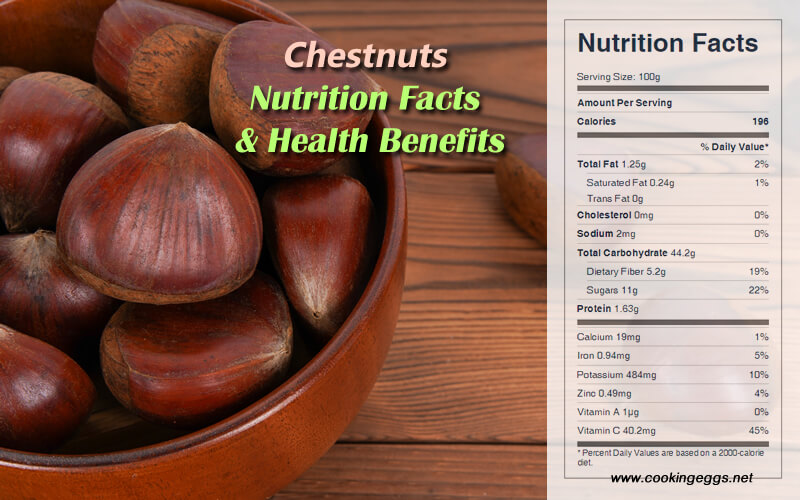Chestnuts Nutrition Facts & Health Benefits
Chestnuts are unusual nuts; they are low in fat and have a high starch content, and they provide vitamin C. They served as a staple food for the poor in many parts of Europe throughout the Middle Ages, when they were made into breads and soups as well as eaten roasted.
The nutritional value of chestnuts
100 grams of raw chestnuts are 60% water and contain 44 grams of carbohydrates, 2 grams of protein, and one gram of fat. Chestnuts provide some B vitamins and dietary minerals in significant amounts.
One ounce of raw European chestnuts provides 60 calories, 12.9 g carbohydrate, 0.7 g protein, 0.6 g fat, 2.3 g dietary fiber, 8 IU vitamin A, 12 mg vitamin C, 18 mcg folic acid, 147 mg potassium, 26 mg phosphorus, 8 mg calcium, and 9 mg magnesium.
Chestnuts have little protein or fat; their calories come chiefly from carbohydrates. Fresh chestnut fruits provide about 200 kcal of food energy per 100 g of edible parts, which is much lower than walnuts, almonds, other nuts, and dried fruit (about 600 kcal per 100 g).

Chestnuts Nutrition Facts Label
Health Benefits of Chestnuts
Nutritionally, chestnuts are lower in calories than most nuts, primarily because they are lower in fat. They are a good source of carbohydrates, and they provide fiber and protein. Chestnuts are also a source of the minerals calcium, potassium, and iron.
The key antioxidants found in chestnuts are vitamin C and manganese. You can get about 70% of your daily vitamin C needs from 3 ounces of chestnuts, as well as manganese, which protects against free radicals.
Chestnuts are among the few nuts that contain vitamin C, with 48% of the daily value in a 100 gram serving. The amount of vitamin C decreases by approximately 40% upon heating.
Chestnuts are high in starch. They can be dried and ground into excellent gluten-free flour. They don’t supply much protein, but they do contain the B vitamins thiamin (B1), riboflavin (B2), and pyridoxine (B6), and potassium.
When chestnuts are just starting to ripen, the fruits are mostly starch and are firm under finger pressure from the high water content. As the chestnuts ripen, the starch is slowly converted into sugar, and the moisture content decreases. Their carbohydrate content compares with that of wheat and rice. Chestnuts have twice as much starch as the potato on an as-is basis. They contain about 8% of various sugars, mainly sucrose, glucose, fructose, and, in lesser amounts, stachyose and raffinose, which are fermented in the lower gut, producing gas.
Chestnuts are also high in fiber, which makes them a great source of prebiotics. When the gut bacteria ferment the fiber you eat, they generate short-chain fatty acids, which is the major benefit: These SCFAs reduce inflammation, improve blood sugar, and aid in overall gut health.
Roasting chestnuts not only improves their flavor, but the heat treatment they get during roasting has a positive effect on their nutritional profile. This process removes the tannins in the inner shell, which contain antinutritional factors, increasing its antioxidant capacity and improving digestibility. An additional analysis assessed the total phenol content of roasted chestnuts and again found it to be significantly higher than that of boiled chestnuts. The key polyphenols exhibiting antioxidant effects include myricetin, kaempferol, fumaric acid, and quercetin. These polyphenols provide a broad range of antioxidant benefits.
Chestnuts contribute overall to improving antioxidant capacity and improving digestibility and gut health. The best part is that roasting them has a positive effect on their nutritional profile!